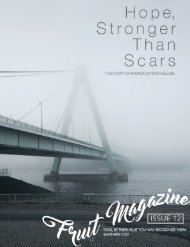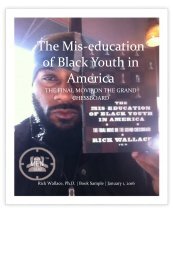Collective Cognitive Dominative Bias Syndrome Theory
Collective Dominative Cognitive Bias Syndrome theory is one of several theories, including Cognitive Accommodation Deficiency Syndrome and Cognitive Assimilation Deficiency Syndrome that explain certain inexplicable and detrimental behavior pattern of African Americans. The proposed research looks to expand these theories, while identifying effective treatment methodologies!
Collective Dominative Cognitive Bias Syndrome theory is one of several theories, including Cognitive Accommodation Deficiency Syndrome and Cognitive Assimilation Deficiency Syndrome that explain certain inexplicable and detrimental behavior pattern of African Americans. The proposed research looks to expand these theories, while identifying effective treatment methodologies!
You also want an ePaper? Increase the reach of your titles
YUMPU automatically turns print PDFs into web optimized ePapers that Google loves.
ABSTRACT<br />
<strong>Collective</strong> <strong>Dominative</strong><br />
<strong>Cognitive</strong> <strong>Bias</strong> <strong>Syndrome</strong><br />
The Odyssey Project Research Funding Proposal<br />
<strong>Collective</strong> <strong>Dominative</strong><br />
<strong>Cognitive</strong> <strong>Bias</strong><br />
<strong>Syndrome</strong> theory is<br />
one of several<br />
theories, including<br />
<strong>Cognitive</strong><br />
Accommodation<br />
Deficiency <strong>Syndrome</strong><br />
and <strong>Cognitive</strong><br />
Assimilation<br />
Deficiency <strong>Syndrome</strong><br />
that explain certain<br />
inexplicable and<br />
detrimental behavior<br />
pattern of African<br />
Americans. The<br />
proposed research<br />
looks to expand these<br />
theories, while<br />
identifying effective<br />
treatment<br />
methodologies!<br />
Rick Wallace, Ph.D.<br />
Lead Researcher
<strong>Collective</strong> <strong>Dominative</strong> <strong>Cognitive</strong> <strong>Bias</strong> <strong>Syndrome</strong> <strong>Theory</strong><br />
Over the past 20 years, I have invested more than 48.000 hours into research that<br />
could explain the unique and highly ambiguous state of African Americans as a<br />
collective — with more than over 26,000 hours in the last decade alone. After<br />
reviewing multitudinous studies and an exorbitant amount of empirical data<br />
concerning the unit of analysis (The African American collective), I have<br />
developed the <strong>Collective</strong> <strong>Dominative</strong> <strong>Cognitive</strong> <strong>Bias</strong> theory, which was an<br />
extension of my initial theory of <strong>Collective</strong> <strong>Cognitive</strong>-<strong>Bias</strong> Reality <strong>Syndrome</strong><br />
(Dissertation forthcoming). The <strong>Collective</strong>-<strong>Bias</strong> Reality <strong>Syndrome</strong> is an influential<br />
cognitive process in which the cognitive distortions of a group of people (In this<br />
case, African Americans) think, process stimuli, form habits and behave based<br />
predominately on those distortions — through a systematic process of deviated<br />
rationalization — creating a reality that is antithetical to that which they desire<br />
most — economic, social and political liberation. The <strong>Collective</strong> <strong>Dominative</strong><br />
<strong>Cognitive</strong> <strong>Bias</strong> theory explains the manner in which <strong>Collective</strong>-<strong>Bias</strong> Reality<br />
<strong>Syndrome</strong> is so dominant that it becomes impossible for African Americans to<br />
maintain cognitive equilibrium through either cognitive process, assimilation or<br />
accommodation.<br />
Normally, when an individual encounters a new intellectual or emotional stimulus,<br />
they identify and engage this stimulus through a process known as assimilation,<br />
which uses the existing schema or schemata to deal with the new object or situation<br />
in a manner in which they maintain cognitive or psychological equilibrium<br />
(McLeod, 2009). However, when an individual’s schema is unsuccessful in helping<br />
them to effectively process new objects and situations, the person enters a state of<br />
disequilibrium, which can be immensely unpleasant. When disequilibrium is<br />
reached, a process known as accommodation begins. Accommodation takes place<br />
when the existing schemas fail to work, and the cognitive structure must be<br />
changed to accommodate the new information. Unfortunately, my initial studies<br />
reveal that the majority of African Americans struggle in both areas of cognitive<br />
and social development. To explain these specific struggles, I developed the<br />
<strong>Cognitive</strong> Assimilation Deficiency <strong>Theory</strong> and the <strong>Cognitive</strong> Accommodation<br />
Deficiency theory.<br />
While Piaget’s theory of schema in cognitive development focuses on the<br />
development of infants and children, I believe that it is applicable here, based on<br />
what I refer to as cognitive impedance, a condition in which any of a number of<br />
variables have contributed to the lack of cognitive progression in the development,<br />
functionality and refinement of thought. While there will have to be certain<br />
adjustments made as far as interpretation and scope, I believe Piaget’s model is<br />
most effective in defining and communicating the psychosocial challenges that<br />
many African Americans are facing daily. However, I will also be looking to<br />
develop a new model and theory that will be exclusive to the African American<br />
experience. This model will take into consideration certain unique variables that are<br />
not currently accounted for in any other model.
During my initial research, I was able to identify no less than 10 dynamic<br />
components that served as contributors to the incessant state of oppression and<br />
dysfunctionality that has become stereotypical, based on its prevalence in African<br />
American society and culture. While institutional racism could be easily identified<br />
(Alexander, 2010) (Anderson, 1994) (Bruda, 1995) (Anderson, 1994) (Burrell,<br />
2010) (Unknown, 2014), it could not explain, in totality, the lack of progress of<br />
African Americans more than 100 years post-slavery (Now, 150 years). In specific,<br />
there were questions that demanded answers and explanations concerning the<br />
collective attitude of African Americans towards work, property, and wealth<br />
(Unknown, 2014) (Desilver, 2013). The physical and systemic mechanisms that<br />
contributed to the perpetual poverty, social dysfunctionality, vacant self-esteem<br />
(Akbar, 1996) (DeGruy, 2005) (Fanon, 1952), self-hatred (Akbar, 1996), violence<br />
(DeGruy, 2009), consumerism and numerous other behaviors and attitudes, which<br />
can be categorized as destructive, could be identified, anatomized and countered;<br />
however, it has proven to be significantly more challenging to develop a lucid<br />
perspicacity of the attitudes of African Americans that create the vacuum of<br />
vulnerability that makes them highly susceptible, and even complicit to the<br />
nefarious machinations that have been implemented through institutional racism.<br />
My initial hypothesis suggested that the behavior of blacks was inextricably<br />
connected with their thought processes (Ajzen, 1991) (Copland, 2011). This initial<br />
hypothesis has been graduated to the theory of collective cognitive-bias reality<br />
syndrome, explaining the perpetual dysfunctionality that operates in a cyclical<br />
dynamic in which counterproductive and destructive behavior literally serves as a<br />
catalyst of counter-progressive momentum. Extant psychological and sociological<br />
theories, such as Dr. Joy DeGruy’s Post Traumatic Slave <strong>Syndrome</strong> (DeGruy,<br />
2005), offer substantial insight into the complex dynamic that functions as an<br />
underwriting mechanism for ill-advised behavior, despite access to resources and<br />
efficacious strategies. DeGruy, along with Howard Stevenson, Ph.D. have provided<br />
lucidity to another psychosocial phenomenon that is prevalent in the black<br />
collective — violence (DeGruy, 2009; Stevenson, 2015; Stevenson, 2006).<br />
To further exacerbate the complexity of my study of the influence of cognitive<br />
biases and cognitive distortions, was the ouroboric theme of multigenerational<br />
trauma. It seems that trauma is one of the primary catalyst to the development of<br />
cognitive biases, and more importantly, cognitive distortions (DeGruy, 2005) was<br />
the presence of unresolved trauma. What was discovered through the anatomization<br />
of the construct of trauma as a primary influencer was quite extraordinary (Kahane-<br />
Nissenbaum, 2011; Kardiner, 1941; Kellermann, 2001; Kolk B. A., 2001; Kolk B.<br />
V., 2014). In answering the question of why African Americans who are 150 years<br />
removed from legalized, chattel slavery, have yet to find their social and economic<br />
equilibrium, we found that a great deal of the dysfunctionality of African<br />
Americans is inextricably connected to unresolved trauma that has been<br />
intergenerationally transmitted — physically, psychologically & genetically<br />
(DeGruy, 2005; Kahane-Nissenbaum, 2011; Kellermann, 2001). This led into other
fascinating fields of research on trauma, including epigenetics (Combs-Orme,<br />
2013; Petronis, 2010; Schmidt, Holsboer, & Rein, 2011; Staff, Epigenetics:<br />
Fundamentals, 2015; Wallace R. , 2016)<br />
Due to the multi-variable components associated with the behavioral sciences, a<br />
substantial portion of the research will be focused on the collection, organization<br />
and analysis of qualitative data; however, the need for more precise and statistical<br />
analysis, as well as the need to understand the thought processes and the<br />
perceptional reality of the target group in a more precise manner, refining the<br />
foundational question, dictates that a certain amount of quantitative research also be<br />
conducted during Phase II of this ongoing research project.<br />
Qualitative & Quantitative Research Matrix (78 Weeks)<br />
Phase 1<br />
Phase 2<br />
Phase 3<br />
Phase 4<br />
Weeks<br />
1-2<br />
Weeks<br />
2-6<br />
Weeks<br />
6<br />
Weeks<br />
6<br />
Use existing data analysis to refine the question:<br />
What are the top three influencing variables that<br />
render Africa Americans ineffective in improving<br />
their quality of life?<br />
— During this time, we will also extract all<br />
quantitative data to be used during the<br />
deductive part of the research in the later<br />
stages of the project<br />
Conduct literature review — studying what others<br />
have written about the specific topic or focus and unit<br />
and of analysis — examining studies associated with<br />
the topic of the focus of this project, drawing up an<br />
analytical report that synthesizes and integrates the<br />
existing research into the expanding study.<br />
— Noting numerical data and its implications<br />
in testing existing and developing concepts,<br />
constructs, hypotheses and theories.<br />
Determine the size of the sample size.<br />
Choose the qualitative methodology, which will<br />
likely be a combination of Ethnography,<br />
Phenomenology, Grounded <strong>Theory</strong> and Case Study<br />
Research<br />
— This is the point in which specific<br />
methodologies and modalities of
Phase 5<br />
Phase 6<br />
Phase 7<br />
Phase 8<br />
Phase 9<br />
Weeks<br />
7-20<br />
Weeks<br />
20-35<br />
Weeks<br />
36-40<br />
Weeks<br />
41-60<br />
Weeks<br />
61-72<br />
quantitative values will be considered. In<br />
addition to the use of surveys, there will be<br />
certain scales developed and used, as well<br />
as the use of available statistical data<br />
associated with the unit of analysis.<br />
Collect data through several data collection<br />
methodologies, including direct observation,<br />
participant observation, interviews document analysis<br />
and surveys<br />
Analyze the data that has been collected to this point<br />
through methodologies, such as coding, descriptive<br />
statistics, narrative analysis, content analysis and<br />
semiotic analysis.<br />
Write the research report on the qualitative<br />
investigation, considering the primary audience.<br />
Beginning the transition from a qualitative focus to a<br />
quantitative approach for the purpose of providing<br />
statistical significance to the hypotheses and theories<br />
being set forth. This is where the process of proving<br />
or disproving these theories will begin. This is also<br />
the point in which theories will be expanded and<br />
redefined based on what the statistics bear out.<br />
Begin studies and surveys that have been developed<br />
internally or through a third party service.<br />
— Analyze and assess the data juxtaposed to<br />
qualitative data and subsequent theories.<br />
Phase 10<br />
Weeks<br />
73-78<br />
Final dissertation on the findings, disseminating the<br />
findings of the research, while setting the direction<br />
for the next phase of research process.<br />
To be clear, a significant amount of the quantitative research and analysis will take<br />
place simultaneously with the qualitative examination, being careful to identify<br />
quantitative data as we progress through the qualitative work. We will use our<br />
qualitative assessments to serve as a guide for engaging our quantitative work.<br />
Simply put, will the numbers be there to support the inductive constructs set forth<br />
as part of the qualitative work. Basically, we will be looking to both, explore and
explain. Information will be collected and converted into quantitative data that can<br />
be analyzed statistically. We will investigate and analyze belief systems and<br />
attitudes concerning religion, finances, wealth building, marriage, education,<br />
entrepreneurship, respect and relationships, etc.<br />
The research that I have conducted to this point has been both, “inductive,”<br />
inferring certain theoretical concepts and patterns (of specific attitudes, cognitions<br />
and behaviors) through fastidious observation and analysis of existing data, as well<br />
as “deductive,” testing the boundaries, accuracy and plausibility of extant concepts<br />
and patterns that have been presented as theory through new empirical data. My<br />
research can best be explained as a dual-dichotomy, in that it is the combination of<br />
two distinct scientific dichotomies — inductive and deductive as well as<br />
exploratory and explanatory. While I am constantly pushing the boundaries of<br />
discovery, I also labor to expand the understanding of existing data and theoretical<br />
constructs, which are primarily multi-dimensional — exacerbating the abstract<br />
elements involved.<br />
With this research being fixed in the realm of social sciences, the difficulty of<br />
measuring that which is consistently imprecise, to explain that which is tangible<br />
and measurable does come with its own specific set of challenges; nevertheless,<br />
using a highly detailed and defined approach to achieving an explanation or<br />
etiology that advances the perspicacity of certain self-destructive behaviors allows<br />
me to elucidate that which has been otherwise ambiguous. Using my experience to<br />
map out the time frame matrix for the coming research, I estimate that this project<br />
will require a minimum of five additional years of research (immensely<br />
conservative). I am currently seeking funding for the next 18 months, but I am<br />
willing to accept partnership with a benefactor that is willing to fund the project in<br />
totality.<br />
A Substantial portion of my work relies heavily on the evaluation and analysis of<br />
the cognitive functionality associated with the African American experience<br />
(Nemade, Reiss, & Dombeck, 2015; Smith & Craddock, 2011) as expressed in the<br />
foundational principle of cognitive theory. The initial question I sought to answer<br />
from this perspective was: Do cognitive distortions or cognitive biases influence<br />
the social mobility and mental health of African Americans? In essence, I sought to<br />
answer the question of the possibility of a collective psychosis that distorted the<br />
African American reality. What I have discovered is so much more. While the<br />
findings are complex, they have offered a positive outlook, because there is nothing<br />
yet discovered that cannot be efficaciously engaged and overcome. Knowing is half<br />
the battle.<br />
Due to the exorbitant amount of empirical data that suggests that cognitions impact<br />
perspective, subsequently impacting perceived reality, it was not difficult to<br />
establish the validity of the core postulation that negative cognitions contributed to<br />
the cognitive biases and cognitive distortions that ultimately led to poor choices<br />
and counterproductive behavior of African Americans. The lack of prosocial<br />
behavior within certain social constructs within the black collective could be traced
directly back to poor social paradigms that form the basis for those behaviors,<br />
especially paradigms that impacted axiology, relationships, work, property, group<br />
economics and overall unity.<br />
Some areas of thought and behavior that I have addressed in my research to this<br />
point include:<br />
Economic castration and impotence (Anderson, 1994)<br />
Ignorance of the political process — leading to poor participation and in influence<br />
within the political process (Wallace R. , 2011; Watkins, 2000)<br />
The view of filial responsibility and the perception of family as it relates to<br />
priorities and social structure<br />
Violence within inner-city neighborhoods, with a specific focus placed on black<br />
male adolescents, who make up a significant portion of the violence in African<br />
American neighborhoods (DeGruy, 2009; Stevenson, 2006; King, 1997).<br />
The Mis-education of Black Youth in the U.S. (Woodson, 1933; Wallace R. , 2015)<br />
Epigenetic influences on behavior and the proclivity for antisocial behavior.<br />
Epigenesis is the biochemical process through which some genes are expressed and<br />
others remain silent, and it reinforces and explains the powerful impact that the<br />
environment has on human development. Epigenetic effects occur not only though<br />
diet, chemical exposure, and high levels of environmental stress, but also through<br />
chronic poverty and racism (Combs-Orme, 2013).<br />
The negative impact of serial forced displacement and benign neglect on the<br />
physical and mental health of African Americans<br />
The impact of negative mass propaganda in the development of a poor self-image<br />
and the subsequent inferiority complex — leading to self-hatred of a significant<br />
portion of the African American population (Burrell, 2010) (Berneys, 1928).<br />
This work addresses the plight of the African American people and the definitive<br />
role of negative or biased cognitions on the social mobility and overall mental health<br />
of the unit of analysis — the African American collective. For the purpose of lucidity,<br />
it is paramount to ensure that there is a clear understanding of the term African<br />
American when considering the group as a unit of analysis within the scope of<br />
scientific research. The diversity of the African diaspora makes identifying a specific<br />
sub-group, such as African Americans, a daunting task. While one could argue that<br />
every American is an African American, based on the scientific data that confirms<br />
that all of humanity descended from and can be traced back to East-Central Africa;<br />
however, the use of such a holistic and inclusive perspective that is grounded in the<br />
history of humankind and the transmission of cultural ethos would be considered<br />
immensely uncommon in Western culture and in the realm of Western thought as it<br />
pertains to the science of psychology and most Western psychological models.<br />
The mono-cultural hegemony of a western dichotomous logic serves to partition<br />
humanity into convenient subgroups that are definable primarily based on external<br />
appearances — with the culture often using these superficial micro variations to
foster generalizations about each group — one of multitudinous cultural and political<br />
mechanisms through which the complex dynamic of cognitive fragmentation,<br />
cognitive biases and cognitive distortions become an influential variable expressed<br />
as frustration and regressive behavior. These ethnic generalizations are a significant<br />
part of the dynamic that victimizes African Americans specifically.<br />
When referring to African Americans in this body of work, it is necessary that we<br />
acknowledge the cultural tendencies in emphasizing the subgroup as a race of people<br />
— taking a more holistic and congruent approach to defining African Americans as<br />
those who have an identifiable connection to the slavery experience, while sharing<br />
physiological, spiritual and historical connections to the continent of Africa —<br />
influencing a highly complex constellation of values, mores, traditions customs,<br />
practices and cultural paradigms that heavily influence their perspective of their<br />
experiences in America — subsequently shaping the manner in which they respond<br />
to their circumstances (Staff, 2003).<br />
It is important to point out that among this group of African Americans, there will be<br />
some who will enthusiastically identify with the continent of Africa and there will be<br />
others who will vigorously fight to distance themselves from any association with<br />
Africa — with both being influenced by the cognitions that form their cultural<br />
paradigms.<br />
Over the past 40 years there has been a well-documented dilemma that has<br />
expressed itself along social, cultural, economic and political lines. The plight of<br />
African Americans has been cataloged in explicit detail. When it comes to the<br />
financial and economic challenges, Dr. Claud Anderson has contributed a couple of<br />
volumes that illuminate various challenges that plague the black community.<br />
According to Dr. Anderson, on the eve of the Civil War, quasi-free blacks owned<br />
less than one half of one percent of the aggregated wealth in the United States, and<br />
155 years later, blacks still own less than one percent of the wealth in the United<br />
States (Anderson, 1994). 1 In his book, Black Labor, White Wealth, Dr. Anderson<br />
goes into an in-depth explanation of what transpired over the course of the 100 plus<br />
years since the emancipation of black slaves in the United States. While it is clear<br />
that there have been external forces that have contributed to the economic<br />
castration and social immobility of blacks in America, the question persists as to<br />
whether blacks have exhibited a certain level of complicity in the perpetuation of<br />
their economic woes.<br />
One of the alleged culprits of the supposed self-inflicted economic castration in the<br />
black community is the strong proclivity of blacks to practice consumerism beyond<br />
their means. According to a written and published work by Tingba Muhammad, of<br />
the NOI Research Group, not only has consumerism played an immense role in the<br />
progression of the economic impotence of the black collective in America, but the<br />
1<br />
Anderson, Claud, Powernomics: The National Plan to Empower Black America, Powernomics<br />
Corporation of America, Inc. 2001
natural inclination of blacks to engage in consumerism at an exorbitant level can be<br />
traced back to slavery (Muhammad, 2014). 2<br />
What makes consumerism so important when evaluating the enigmatic dilemma that<br />
blacks are facing in the United States, is the fact that consumerism in one of the<br />
primary streams of revenue that supports the development and sustainment of the<br />
white, wealthy, elite economic infrastructure in America. With the natural hostility<br />
that exists between the white and black races, consumerism plays a major role is<br />
sustaining the significant economic advantage that whites have over blacks in this<br />
country (Anderson, 1994). The wealth gap is important because the wealth provides<br />
the power and influence that is consistently used to emasculate any attempt of blacks<br />
to elevate themselves, subsequently leading to the conclusion that by participating in<br />
consumerism, blacks are, in essence financing their own demise.<br />
It is the point of this work to not only present evidence that blacks are complicit in<br />
their economic castration, through consumerism and a number of other fallible<br />
financial practices, including failure to invest, the failure to build an organized group<br />
economic infrastructure and the failure to practice group economics, but also to<br />
present pragmatic and empirical evidence that a substantial portion of the behavior<br />
associated with these erroneous and unsound practices can be attributed to cognitive<br />
distortions that have served to develop faulty paradigms that guide the decisions and<br />
behaviors of blacks in all nine areas of human activity: economics, education,<br />
entertainment, labor, law, politics, religion, sex and war (Welsing, 1990).<br />
The cultural dilemmas that plague the black community are multitudinous and stem<br />
from a form of individualism that facilitates a level of acrimony, disruptiveness and<br />
divisiveness. The schismatic factions that exist within the black community are<br />
increasing at an exponential rate. Walter Williams, a professor of economics at<br />
George Mason University, presents his thesis on the black dilemma in short form,<br />
presenting a hypothesis that attributes the problems of the black collective to culture<br />
more than racism (Williams, 2015). 3 One area in black culture that Williams<br />
highlights is the disintegration of the black family nucleus, with only 35 (currently<br />
closer to 25 percent) percent of black children being raised in a two-parent<br />
household. This particular statistic is immensely relevant when considering the<br />
existing data that is available confirming that growing up without both parents,<br />
places youth at a significant disadvantage to those who have both parents in the<br />
home. According to a study conducted by the University of Wisconsin and The<br />
University of Ohio, on average, children who grow up spending some or all of their<br />
2<br />
Muhammad, Tingba, Wasteful Black Consumerism: Set in Motion by Slavery, NOI Research<br />
Group, 2014<br />
3<br />
Williams, Walter, Most Serious Problems for Blacks Rooted in Culture, Not Racism, The Citizen,<br />
2015
time away from one of their parents are worse off than children who are raised with<br />
both parents in the home (Kirby, 2015).<br />
In addition to studying the link between cognitive distortions and behavior in African<br />
Americans, I will give careful consideration to external influencers, such as negative<br />
propaganda, cultural experiences, economic castration, unemployment, disrespect<br />
(especially as it relates to adolescent males), miseducation, the school-to-prison<br />
pipeline, mass incarceration and the attack on the African American family nucleus.<br />
The next phase of my research will extend existing theories, with substantial<br />
attention given to <strong>Cognitive</strong> Assimilation Deficiency <strong>Syndrome</strong> and <strong>Cognitive</strong><br />
Accommodation Deficiency <strong>Syndrome</strong>. A substantial amount of effort will be<br />
invested in bearing out effective modalities for efficaciously addressing these<br />
negative forces in a way that will increase the functionality and mobility of African<br />
Americans that will allow them to successfully engage their current state of<br />
poverty, oppression and fragmentation.<br />
When studying the intergenerational transmission of trauma, which includes<br />
psychological, physical and genetic components, the vast majority of work on<br />
human group subjects was conducted on Jewish Holocaust survivors. What stood<br />
out the most was the amount of money and effort the first generation (those who<br />
actually experienced the Holocaust) invested in research and studies to understand<br />
how they were effected, and to determine how they would reduce the generational<br />
impact. Because of their investments, they are experiencing exceptional<br />
improvements in the mental health and performance of the third generation, or the<br />
second generation removed. African Americans are currently in their sixth<br />
generation removed, and I believe that one of the reasons that we have failed to<br />
progress is the lack of interest in understanding how we were impacted by slavery,<br />
in order to determine how we can overcome it — allowing subsequent generations<br />
to step out of the chains of mental slavery.<br />
Most of the research into the black dilemma has been funded by educational<br />
institutions and government agencies, with very little funding coming from the<br />
private sector within the African American community. This lack of interest in<br />
understanding and effectively engaging our trauma-related issues has sentenced us<br />
to perpetual suffering.<br />
As you can imagine research is not without cost, and following is the research<br />
budget for the next 18 months.
The Odyssey Project Research Budget for Next 18 Months<br />
Description Category Projected Cost Actual Cost Difference Actual Cost Overvi<br />
CD+R for Storing Data Supplies $50 $50<br />
Dragon Medical Practice Dictation Software Equipment $75 $75<br />
Duplication Services (Reports) Gifts and Charity $250 $250<br />
Editorial Assistant Research Services $1,120 $1,120<br />
ISR Services (Surveys) Research Services $15,000 $15,000<br />
Lead Researcher Salary Personnel Expenses $150,000 $150,000<br />
Mac Book Pro (Laptop) Equipment $2,705 $2,705<br />
Model & Scale Development Research Services $15,000 $15,000<br />
NUDIST 4.0 Analytic Software Equipment $375 $375<br />
Office Supplies Supplies $2,500 $2,500<br />
Periodicals, Journals & Books Resource Material $3,800 $3,800<br />
Program Development & Implementation Research Services $25,000 $25,000<br />
Periodicals, Publication Journals Costs & Books Dissemination Costs $2,475 $2,475<br />
Questionnaire Forms Supplies $150 $150<br />
Report Materials & Supplies Supplies $300 $300<br />
Research Assistant Personnel Expenses $64,361 $64,361<br />
Travel Expenses Travel $25,000 $25,000<br />
Video/DVD (Rental) Equipment $530 $530<br />
Total $308,691 $0 $308,691
Budget Justification
Travel Expenses<br />
Intrastate and Interstate travel will be necessary to accomplish a number of the goals<br />
of the research, including on-site and field interviews, field observation and onlocation<br />
research. The expenses proposed here are an estimation of travel costs for<br />
the next 18 months, and the estimation does not include international travel.<br />
Research Assistant<br />
The research assistant will be a psychology or sociology major with at least a fouryear<br />
university degree. He/she will accompany the primary investigator during life<br />
history interviews to provide assistance in comprehending collected data. In addition,<br />
he/she will provide commentary, explanations, and observations to facilitate the<br />
primary investigator’s participant observation. During the first phase of the project,<br />
the research assistant will work forty hours a week and occasional overtime as<br />
needed. During phases two and three, the assistant will stay with the investigator<br />
overnight in the field when necessary.<br />
Research Director<br />
As the research director, I will direct and oversee the clinical research function of<br />
the project. I will also be responsible for functioning as the lead researcher —<br />
making the final analysis, conjectures and predictions based on the collected and<br />
generated data. I will also create research studies, standards and guidelines for the<br />
research and programs. It will also be my responsibility to ensure that all standards<br />
and good clinical practices are adhered to. The median for a Research Director is<br />
$157,063, and while I am one of several psychosocial researchers with the range to<br />
take on this task, I am willing to take a cut in what would be fair market pay in<br />
order to ensure that the research is completed.<br />
Mac Book Pro (Laptop)<br />
A laptop computer will be necessary for recording observations, thoughts, and<br />
analysis during the research project.<br />
NUDIST 4.0 Software<br />
NUDIST 4.0 Software, “Non-numerical, Unstructured Data, Indexing, Searching,<br />
and Theorizing,” is necessary for cataloging, indexing, and managing field notes<br />
both during and following the field research phase. The program will assist in<br />
cataloging themes that emerge during the life history interviews. It is the most<br />
widely used of all analytic software programs.<br />
Supplies<br />
All entry categories designated as supplies are considered to be basic supplies that<br />
are necessary to facilitate the research throughout its duration.
Research Services<br />
Research services refer to professional third-party services that provide integral<br />
services, such as research-program development, research-specific surveys and<br />
program administration. This category also includes research model and scale<br />
development.<br />
The following sources are a short list of sources and references consulted as a part<br />
of the preliminary research for this project, as well as references consulted during<br />
previous research through which extant theories were generated.<br />
Bibliography<br />
Ajzen, I. (1991). “The <strong>Theory</strong> of Planned Behavior,” Organizational Behavior and Human<br />
Decision Processes (50). Icek Ajzen, 179-211.<br />
Akbar, N. (1996). Breaking the Chains of Psychological Slavery. Tallahasee, FL: Mind<br />
Productions & Associates, Inc.<br />
Alexander, M. (2010). The New Jim Crow: Mass Incarceration in the age of<br />
Colorblindness. New York City : New York Press.<br />
Anderson, C. (1994). Black Labor, White Wealth. Bethesda, MD: Powernomics<br />
Corporation of America.<br />
Berneys, E. (1928). Propaganda . Brooklyn, NY: IG Publishing.<br />
Bruda, J. (1995). Henry Kissinger's 1974 Plan for Food Control Genocide. Schiller<br />
Institute, 1.<br />
Burrell, T. (2010). Brainwashed: Challenging the Myth of Black Inferiority. New York:<br />
Smiley Books.<br />
Christian, M. (1991). An African-Centered Perspective on White Supremacy. Xavier<br />
University College of Black Studies, 268.<br />
Combs-Orme, T. (2013). Epigenetics and The Social Work Imperative. University of<br />
Tennessee, College of Social Work.<br />
Copland, A. (2011). <strong>Cognitive</strong> Behavioral <strong>Theory</strong>. The Center for <strong>Cognitive</strong> and<br />
Behavioral Science.<br />
DeGruy, J. (2005). Post Traumatic <strong>Syndrome</strong>: America's Legacy of Enduring Injury and<br />
Healing. Portland, OR: Uptone Press.
DeGruy, J. (2009). The African American Adolescence Respect Scale: The Measure of<br />
Prosocial Attitude. The University of Portland, 1-3.<br />
Desilver, D. (2013). Black Incomes are Up, But Wealth Isn't. pew Research Center.<br />
Fanon, F. (1952). Black Skin, White Mask. London: Pluto Press.<br />
Kahane-Nissenbaum, M. C. (2011). Exploring Intergenerational Transmission of Trauma<br />
in Third Generation Holocaust Survivors. University of Pennsylvania Scholarly<br />
Commons.<br />
Kardiner, A. (1941). The Traumatic Neurosis of War. New York: Hoeber.<br />
Kellermann, N. P. (2001). Transmission of Holocaust Trauma - An Integrative View.<br />
Israel Journal of Psychiatry, 256-267.<br />
King, A. E. (1997). Understanding Violence Among Young African American Males: An<br />
Afrocentric Perspective. Journal of Black Studies, 79-86.<br />
Kirby, J. (2015). Single Parent . The Ohio State University.<br />
Kolk, B. A. (2001). Exploring the Nature of Traumatic Memory: Combining Clinical<br />
Knowledge with Laboratory Methods. Trauma and <strong>Cognitive</strong> Science Haworth<br />
Press, Inc.<br />
Kolk, B. V. (2014). The Body Keeps the Score. New York: Penguin Publishers.<br />
McLeod, S. (2009). Jean Piaget. Simply Psychology.<br />
Muhammad, T. (2014). Wasteful Black Cosumerism: Set in Motion by Slavery. Nation of<br />
Islam Research Group.<br />
Nemade, R., Reiss, N. S., & Dombeck, M. (2015). <strong>Cognitive</strong> Theories of Major<br />
Depression - Aaron Beck - Depression: Major Depression & Unipolar Varieties .<br />
Beck Institute.<br />
Petronis, A. (2010). Epigenetics as a Unifying Principle in the Aetiology of Complex<br />
Traits and Diseases. Nature, 721-727.<br />
Schmidt, U., Holsboer, F., & Rein, T. (2011). Epigenetics Aspects of Post Traumatic<br />
Stress Disorder. Max Planck Institute of Psychology.<br />
Smith, D. J., & Craddock, N. (2011). Unipolar and Bipolar Depression: Different of the<br />
Same? The British Journal of Psychology.<br />
Staff, E. (2003). Psychological Treatment of Ethnic Minority Populations. Society of<br />
Indian Psychologists, 13-18.<br />
Staff, E. (2015). Epigenetics: Fundamentals. What is Epigenetics, 1.
Stevenson, H. C. (2006). Parents' Ethnic-Racial Socialization Practices: A Review of<br />
Research and Directions for Future Study. American Psychological Association, 1-<br />
24.<br />
Stevenson, H. C. (2015). Development of the Teenager Experience of Racial Socialization<br />
Scale: Correlates of Race-Related Socialization Frequency from the Perspective of<br />
Black Youth. The Journal of Black Psychology.<br />
Unknown. (2014). African Americans: From Segregation to Modern Institutional<br />
Discrimination and Modern Racism. New York: Sage Publications.<br />
Wallace, R. (2011). Benign Neglect and Planned Shrinkage. Brookly History.<br />
Wallace, R. (2015). The Miseducation of Black Youth in America: The Final Move on the<br />
Grand Chessboard. Etteloc Publishing.<br />
Wallace, R. (2016). Epigenetics & Psychology: The Genetic Intergenerational<br />
Transmission of Trauma. The Odyssey Project.<br />
Watkins, B. (2000). Fantasy, Decay, Abandonment, Defeat and Disease: Community<br />
Disintegration in Central Harlem 1960-1990. New York, NY: Columbia<br />
University.<br />
Weaver, I. (2015). Epigenetics in Pyschology. The NOBA Project.<br />
Welsing, F. C. (1990). The Isis Papers. New York: Third World Press.<br />
Williams, W. (2015). Most Serious Problems fro Blacks Rooted in Culture, Not Racism.<br />
The Citizen.<br />
Woodson, C. G. (1933). History as a Weapon: The Mis-education of the Negro. Seven<br />
Treasures Publications.<br />
Woodson, C. G. (1933). The Mis-education of the Negro. New York: Seven Treasures<br />
Publiscations.

















